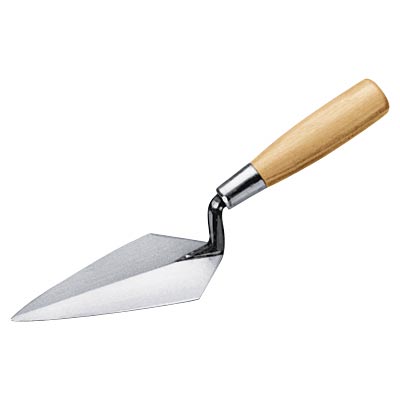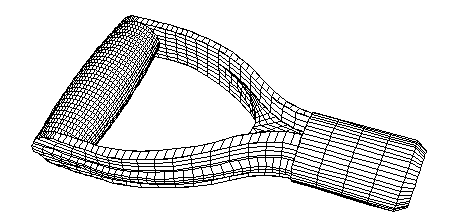
A dibble (or dibber) can be a very nice tool to have. Essentially, it’s a handheld poking tool that creates a planting hole in the ground. The tool is generally cylindrical and comes to a point, somewhat like a stubby, sharpened pencil; larger ones may have a curved handle. End to end, the dibble may be up to 10 or 12 inches long. Fat ones are popular for bulb-planting or creating a hole for a larger seedling, while skinny ones are great for planting seeds or setting out smaller seedlings.
Why bother with dibbles? Because like any good tool, they make a project easier — your hand becomes much slower to tire. You can purchase one of many examples available from your local garden supplier, or you can make your own by sharpening a broken hoe, shovel, or broom handle. For small jobs, you can use a sharpened pencil or wooden dowel. Though a simple tool, a good dibble is often a two-part item. The top half, or handle, allows a comfortable grip and thus is usually wood or strong, durable plastic. If designed well, you should be able to grab the dibble almost like a pistol or screw gun, which reduces stress to your hand and wrist as you work. In any event, the bottom or digging or prodding half is best made out of strong, stiff metal, such as carbon steel.
Some dibbles have a hollow tip so that when the tool penetrates soil, the dibble captures displaced soil so you can set it aside. However, if you’re working in clay, this type of tool probably isn’t your best bet, because the soil tends to get stuck in the hollow and can be difficult to remove.
Owing to its smaller size and the scope of appropriate planting projects (namely, planting bulbs or seedlings), you shouldn’t be stooping or bending when using your dibble. Sit or squat on the ground, or kneel. This position also allows to you keep an eye on hole depth. Don’t get carried away, lazy, or tired and start plunking things into too-deep holes!





 The reason the shaft is straight is simple: Bends or curves create weak or stress points. Do check that the tool you’re thinking of buying has a nice, straight handle. Material is equally important. A “solid hardwood handle,” although desirable, is also rather vague. You want a strong, solid, splinterresistant wood; ash is considered the best, with hickory in second place. Maple is okay, too, though it’s heavier and can break in unpredictable ways.
The reason the shaft is straight is simple: Bends or curves create weak or stress points. Do check that the tool you’re thinking of buying has a nice, straight handle. Material is equally important. A “solid hardwood handle,” although desirable, is also rather vague. You want a strong, solid, splinterresistant wood; ash is considered the best, with hickory in second place. Maple is okay, too, though it’s heavier and can break in unpredictable ways. 
 You can find deep and abiding pleasure in a good tool, in finding and using the right equipment for the job at hand. This statement is as true for gardening as it is for, say, cooking or woodworking. In this chapter, I survey the tools you probably need (and want) to aid you with your gardening, and I advise you on their selection and care. Here’s where you get to roll up your sleeves at last and get into the really satisfying work that’s the heart and soul of successful gardening. Quality, well-chosen tools allow you to put your plans into action! This chapter covers the most common and general tools you likely need for successful gardening, and it includes pointers on how to pick the best ones. (I also list some suppliers in the Appendix, in case you need a starting point.) The difference between the right tool and the wrong tool is the difference between back-breaking labor and joyful efficiency.
You can find deep and abiding pleasure in a good tool, in finding and using the right equipment for the job at hand. This statement is as true for gardening as it is for, say, cooking or woodworking. In this chapter, I survey the tools you probably need (and want) to aid you with your gardening, and I advise you on their selection and care. Here’s where you get to roll up your sleeves at last and get into the really satisfying work that’s the heart and soul of successful gardening. Quality, well-chosen tools allow you to put your plans into action! This chapter covers the most common and general tools you likely need for successful gardening, and it includes pointers on how to pick the best ones. (I also list some suppliers in the Appendix, in case you need a starting point.) The difference between the right tool and the wrong tool is the difference between back-breaking labor and joyful efficiency. A sometimes overlooked necessity for plant life is air (and not just carbon dioxide). Without air, plants struggle and perish. Yes, the free oxygen in the air is part of the photosynthesis recipe, produced by the plants themselves, but another practicality is even more visible here. Air movement around your plants prevents disease, especially fungal diseases that gain a foothold when the air is too “close” and humid and when wet leaves can’t dry or don’t dry quickly.
A sometimes overlooked necessity for plant life is air (and not just carbon dioxide). Without air, plants struggle and perish. Yes, the free oxygen in the air is part of the photosynthesis recipe, produced by the plants themselves, but another practicality is even more visible here. Air movement around your plants prevents disease, especially fungal diseases that gain a foothold when the air is too “close” and humid and when wet leaves can’t dry or don’t dry quickly.